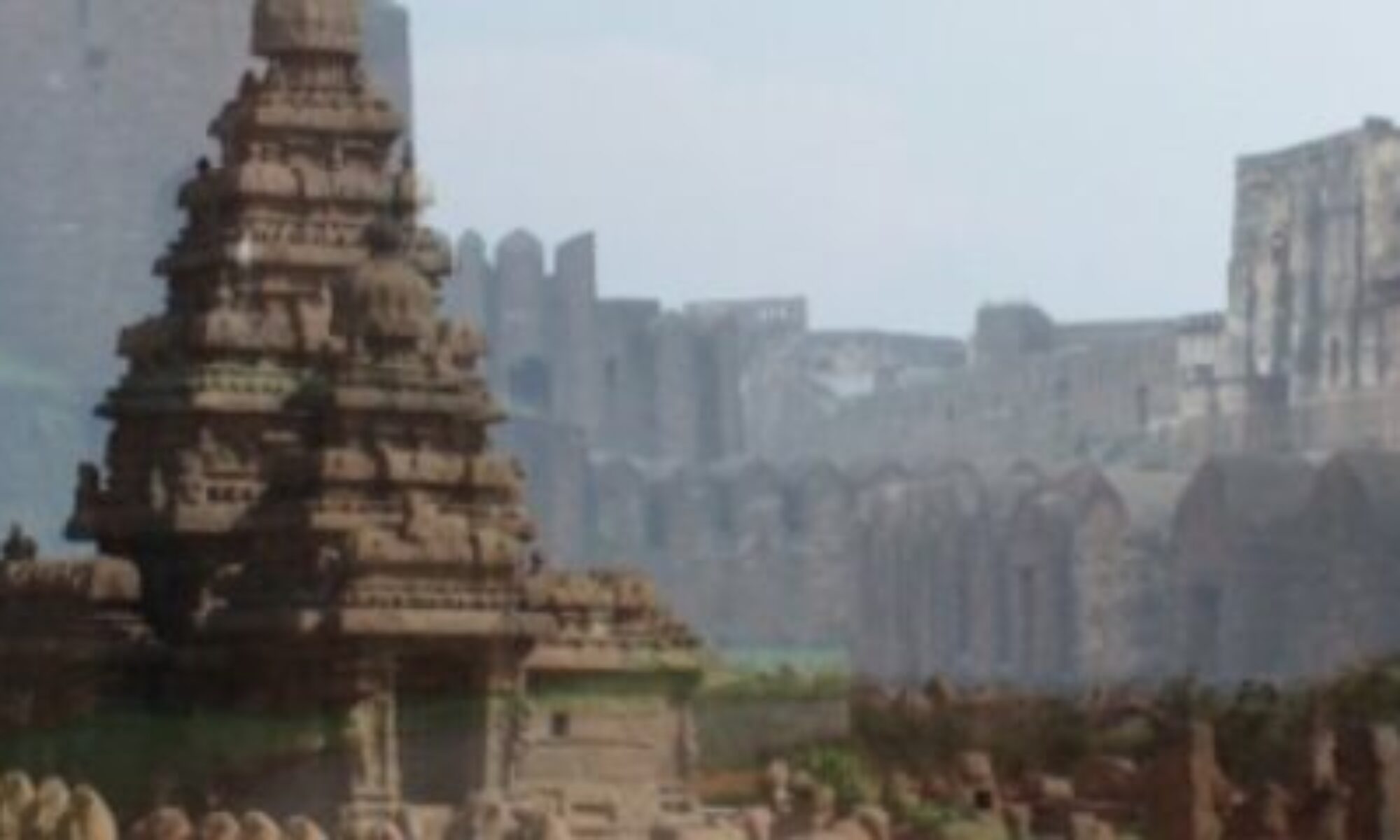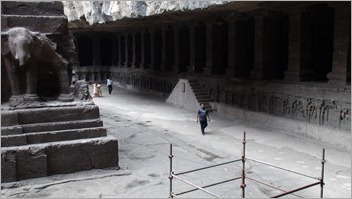 What makes Ellora stand unique apart from the amazing sculptures? The length of the cantilever is 26 feet without any pillar support. The height of the mountain in which the caves are excavated is 107 feet. If we leave the 30 feet which has been excavated, there is still 70 feet of the mountain. Even after 1000 years, this cantilever is intact holding the thousands of tons of stone on it. In fact, not even a single piece of sculpture was dam
What makes Ellora stand unique apart from the amazing sculptures? The length of the cantilever is 26 feet without any pillar support. The height of the mountain in which the caves are excavated is 107 feet. If we leave the 30 feet which has been excavated, there is still 70 feet of the mountain. Even after 1000 years, this cantilever is intact holding the thousands of tons of stone on it. In fact, not even a single piece of sculpture was dam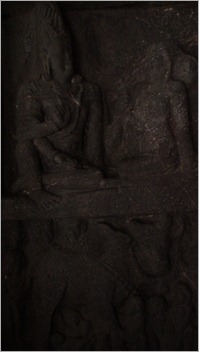 aged when Ellora too felt the tremors of India’s worst earthquake in 1993 at Latur which is just 300 kilometers from here. The Kailas was excavated in two models. First, the temple structure was chiseled top to bottom and later the corridors, front to back.
aged when Ellora too felt the tremors of India’s worst earthquake in 1993 at Latur which is just 300 kilometers from here. The Kailas was excavated in two models. First, the temple structure was chiseled top to bottom and later the corridors, front to back.
Now let us walk through the left corridor.
1) Siva defending the sage Markandeya against Yama. Yama holds the noose while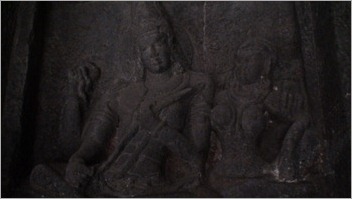 Siva is shown as obstructing Yama from taking the life out of Markandeya.
Siva is shown as obstructing Yama from taking the life out of Markandeya.
2) Siva and two worshippers, one with a bow, club and snake.
3) Siva and Parvati playing the dice gate. Nandi and ganas below.
4) Siva and Parvati sitting together. He is shown playing the Rudra Veena for Parvati’s entertainment.
5) 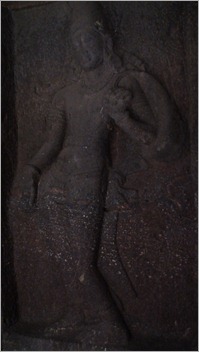 Siva and Parvati with her arm entwined in his. Ravana was intended to be represented below trying to l
Siva and Parvati with her arm entwined in his. Ravana was intended to be represented below trying to l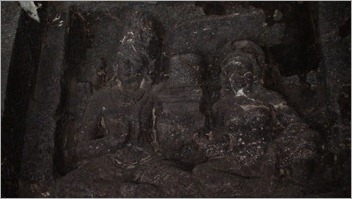 ift the Kailas mountain, the the sculpture was left unfinished as the rock would not have been suitable for carving.
ift the Kailas mountain, the the sculpture was left unfinished as the rock would not have been suitable for carving.
6) A two-armed figure (probably Rishi Muchikund) with a bag on his left shoulder and in the dana mudra. Another interpretation is that this denotes the person who financed the entire carving of Ellora.
7) Siva and Parvati sitting facing each other. Perhaps he is narrating some story to her.
8) Siva with cobra and rosary, and Nandi to his right.
9) Siva and Parvati seated, and Nandi couchant below.
10) The same pair with a linga altar below, for Parvati to worship. Nandi below.
11) Siva and Parvati on his left knee; a seated and a standing figure below.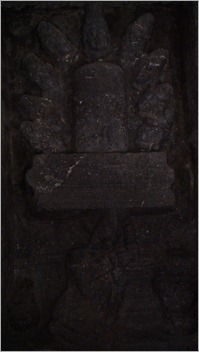
12) Below, a kneeling figure of Ravana upholding the salunkha or altar on which is a linga, with nine of his heads, which has has already cut off 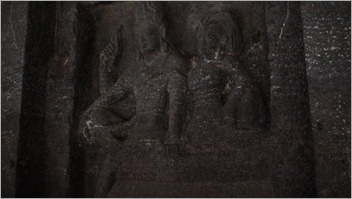 around it, while he is in the act of cutting off his tenth; at this juncture Siva, pleased with his devotion, interferes, and tells him to ask for any boon he chooses Siva himself by which he received Siva in the form of Atma Linga. We had seen a sculpture related to this in the previous post.
around it, while he is in the act of cutting off his tenth; at this juncture Siva, pleased with his devotion, interferes, and tells him to ask for any boon he chooses Siva himself by which he received Siva in the form of Atma Linga. We had seen a sculpture related to this in the previous post.
One interesting aspect in this row of sculptures where Siva and Parvati are sitting together is that Parvati is shown of lesser height. Whereas, sculptures at all other locations, not only in this cave but among all the Caves in Ellora, Siva and Parvati are depicted of equal height. Change in the craftsmen could be one reason, the other being non availability of enough carving space.
A door from the last corridor leads into a continuation of it, almost 60 feet but without sculptures on the back.; however the two front pillars are elegantly ornamented. Again the reason for this unfinished nature can be attributed to the suitability of the rock. We can see the chisel marks on the back of this corridor.
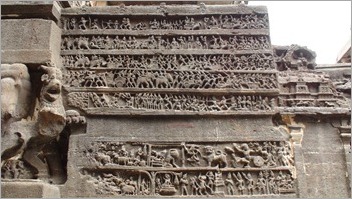 Descending from this corridor, we move towards the main shrine. The side wall, like earlier is carved with the story of an epic, this time is Mahabharata. We shall start from the bottom.
Descending from this corridor, we move towards the main shrine. The side wall, like earlier is carved with the story of an epic, this time is Mahabharata. We shall start from the bottom.
1) Extreme right is Kamsa killing the previous brothers of Lord Krishna and a bed with a woman and a child. This is the birth of Lord Krishna. Moving towards the left, we see Vasudev carrying Lord Krishna to Gokul. Next is shown Poothana feeding poisonous milk to Krishna. Next is shown Krishna as a child at the grinding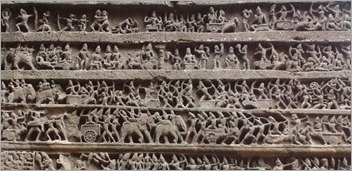 machine and the milk churning machine and Krishna along with cattle herd.
machine and the milk churning machine and Krishna along with cattle herd.
2) Krishna on a bed fighting with Bakasura in the form of an eagle. Krishna is shown stealing butter out of a pot and a panel of cow being milked.
3) The upper panels represent the war between the Kauravas and Pandavas. It is difficult to identify who is who as there is no specific icon. However, a couple of sculptures can be identified as Bheema with his mace, and one while Bheema killing Dussasana.
We now enter the main shrine, through the staircase where we had seen Siva in the Roudra Form and like a Buddha. This staircase leads to the porch of the shrine.
